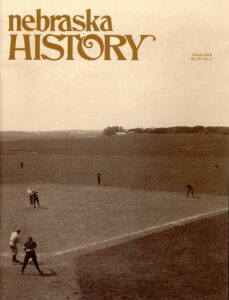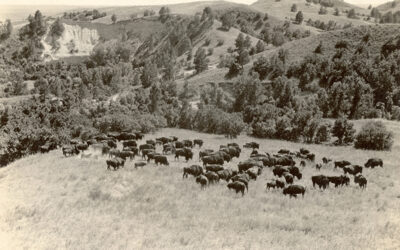
John Nelson’s photograph of a baseball game includes a catcher with face mask in the left foreground. NSHS RG3542:PH:097-12 (at right).
The catcher’s mask in baseball was invented by Frederick W. Thayer, a Harvard baseball player who once played the game in Omaha. He modified a fencing mask which enabled the catcher to move closer to home base and receive the ball without fear of being struck in the face. Thayer received a patent for his invention early in 1878. Later in the year, A. G. Spalding and Brothers Company, the leading American sporting goods dealer, began selling the Thayer Catcher’s Mask for $3. In 1883 Thayer sued Spalding for patent infringement, and Spalding was ultimately forced to pay royalties. The Omaha Daily Bee on April 6, 1886, noted Thayer’s recent patent victory and recalled his baseball days in Omaha: “Old ball players in Omaha and lovers of the sport, who have watched the game for the last seven years, will remember the first professional nine organized in this city in the fall of 1879. . . . In two of the most important games played the nine was reinforced by a clerk from the B & M headquarters, Fred Thayer, whose brilliant fielding and tremendous batting elicited tumultuous applause from the audience. Thayer . . . is now brought into prominence through being the winner of a heavy patent suit, involving the invention of the catchers’ masks.”

The Winter 2004 issue of Nebraska History (above) includes several articles on the history of baseball in Nebraska: “Growing Pains in the River City: The Development of Professional Baseball in Nineteenth-Century Omaha,” by Angelo J. Louisa and Robert P. Nash; “Local Heroes: Nebraska Hometown Baseball,” by Andrea I. Faling; “‘A Role New to the Race’: A New History of the Nebraska Indians,” by Jeffrey Powers-Beck; and “‘Too Much Dirty Work’: Race, Manliness, and Baseball in Gilded-Age Nebraska,” by Gregory Bond. – Patricia C. Gaster, Assistant Editor for Research and Publications



